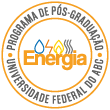Banca de DEFESA: THAIS CORDEIRO PRATES
Uma banca de DEFESA de MESTRADO foi cadastrada pelo programa.STUDENT : THAIS CORDEIRO PRATES
DATE: 05/06/2023
TIME: 14:00
LOCAL: Auditório 801 no 8º andar do Bloco B do Campus Santo André da Universidade Federal do ABC
TITLE:
PERFORMANCE ANALYSIS OF SINGLE-FACIAL AND TWO-FACIAL PHOTOVOLTAIC PLANTS WITH AND WITHOUT SOLAR TRACKING
PAGES: 100
BIG AREA: Outra
AREA: Planejamento Energético
SUMMARY:
To improve the performance of photovoltaic systems, solar tracking structures have been widely used in photovoltaic plants, as well as the bifacial modules that are the new bet in the solar market. In bifacial technology, the energy conversion process is affected by factors such as the albedo and the installation height of the modules. The lack of studies on the influence of these factors on the productivity of photovoltaic plants is a significant barrier to the expansion of this technology in the country. This work presents and compares simulation results for a 30 MW photovoltaic plant with single and bifacial modules, with and without solar tracking structures in Northeast Brazil and performs a sensitivity analysis to determine the effect of these factors on plant productivity. Tracker gains, bifacial gains, and bifacial tracker gains were calculated and compared for each setting. The average annual gain of the tracker is 9% for monofacial systems and 8% for bifacial systems. The average annual bifacial gain is 6.3% for fixed systems and 5.5% for mobile systems and the combination of technologies can generate gains between 7 and 22%. The monofacial system with a sun tracker outperforms a fixed inclined bifacial system by 3.4%. The sensitivity analysis demonstrated that the bifacial modules must be installed at a high enough height to reduce the effects of self-shading, in addition, the annual increase in productivity of the bifacial plants is directly proportional to the surface albedo. For the region, the optimal installation height is between 2.5 and 3.00 meters. Raising the installation height of modules under low albedo conditions can maximize bifacial gains to 8.4%. In high albedo conditions this gain is maximized between 19% and 24%. The potential of combining these technologies can increase the technical viability of photovoltaic plants in Brazil.
COMMITTEE MEMBERS:
Presidente - Interno ao Programa - 2333950 - CONRADO AUGUSTUS DE MELO
Membro Titular - Examinador(a) Interno ao Programa - 2236209 - RICARDO DA SILVA BENEDITO
Membro Titular - Examinador(a) Externo ao Programa - 1544274 - SERGIO HENRIQUE FERREIRA DE OLIVEIRA
Membro Suplente - Examinador(a) Interno ao Programa - 1734918 - PAULO HENRIQUE DE MELLO SANT ANA
Membro Suplente - Examinador(a) Externo à Instituição - ANDRE FELIPE SIMOES - USP




